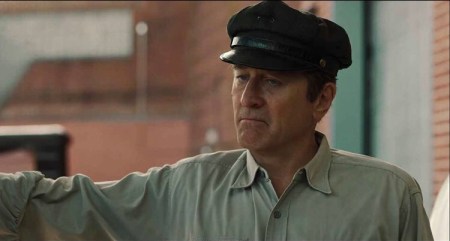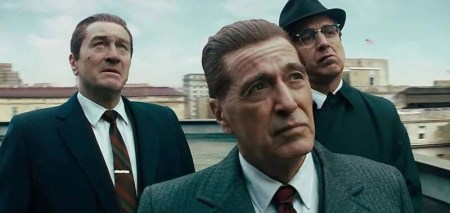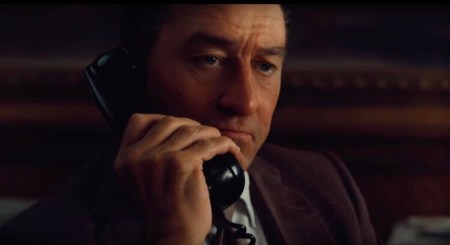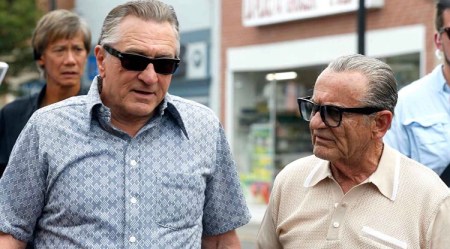The Irishman

Director: Martin Scorsese.
Screenplay: Steven Zaillian.
Starring: Robert DeNiro, Al Pacino, Joe Pesci, Harvey Keitel, Stephen Graham, Bobby Cannavale, Anna Paquin, Jesse Plemons, Ray Romano, Domenick Lombardozzi, Jake Hoffman, Steven Van Zandt, Jack Huston, Katherine Narducci, Welker White, Stephanie Kurtzuba, Louis Cancelmi, Sebastian Maniscalco, Paul Ben-Victor, Paul Herman, Jim Norton, J.C. MacKenzie, Barry Primus.
“You might be demonstrating a failure to show appreciation”
Way back in 1973, Robert DeNiro and Martin Scorsese worked together for the first time with Mean Streets. It was a vibrant and creative crime film that put them both in very high estimation and their careers flourished as a result. They would go on to collaborate a total of eight times which delivered such iconic work as Taxi Driver, Raging Bull and Goodfellas, to name a few. Throughout this time they earned a reputation for quality and it’s very difficult to name another actor/director collaboration that’s produced as much greatness. Now, after a 24 year wait (since Casino in 1995) they return to the gangster milieu of which they have become synonymous with. It’s now their ninth film together and it’s, unsurprisingly, another work of real substance.

Plot: In 1950’s America, Frank Sheeran (Robert DeNiro) is a resourceful truck driver who happens to cross paths with powerful crime boss Russell Bufalino (Joe Pesci). As their friendship grows, Russell takes a shine to Frank and gives him plenty of work and opportunities which result in him becoming a mob enforcer before being put to work alongside Teamsters boss Jimmy Hoffa (Al Pacino). Hoffa’s volatility, however, begins to put Frank in an awkward position which leaves him torn between two important friendships where serious choices have to be made.

From the opening tracking shot through a nursing home while The Five Satins’ “In the Still of the Night” plays overhead to DeNiro’s informative voiceover as he recounts his past involvement in organised crime, it instantly feels like we’re back on Scorsese’s comfortable playground. Despite the years that have past as viewers, though, it strangely feels like we never left such is the lasting impact that their previous collaborations have had.

One can never accuse Scorsese of a lack of mature filmmaking but this has a different approach that suits the ageing careers of himself and the solid cast. There’s a languid and melancholic pace and at a lengthy 3 hours and 29 mins it could test the patience of many viewers looking for a retread of Scorsese’s previous work. It’s abundant with wiseguys but Goodfellas this ain’t and anyone expecting that fast pace will likely be disappointed. However, for the themes of loyalty and betrayal and the choices and consequences in life which span decades, the pace and tone is very much appropriate. This is a reflective film for the times and the real-life people involved but it also feels reflective for Scorsese and his trio of actors as well. We are witnessing screen legends in their twilight years who may not have much more left in them. They know it and we know it and that’s what brings a sobering realisation of mortality which is the basis on which the film operates.

By now, though, everyone will be aware of the de-ageing or “youthification” special effects to make the actors look younger and be able to play themselves in their 30’s, 40’s or 50’s. Initially, it’s slightly distracting but it really doesn’t take long to adapt to it and it’s an interesting and state of the art technique that will most likely revolutionise how movies can be made now. Essentially, this CGI de-ageing is just a more advanced method of using make-up which has always been a part of the movie making process anyway. For the most part, it’s quite effective but some refinement is definitely required. The only major issue that this couldn’t quite correct, however, was posture. Sometimes the stiffness of the 70+ actors shows in their movements when playing their younger selves but despite this, it’s still quite a remarkable achievement that can only improve over time.

As the film leaps back and forth throughout the decades, the trio of actors all get their moments to shine – and all for very different reasons; DeNiro spearheads the film and is rarely offscreen for the entirety of its duration. Holding it all together with a stoic brilliance, you could say that he has the harder role to play. Sheeran is a character that displays very little emotion and even though it can look like he’s doing nothing, DeNiro has full command of the screen. In fact, it’s a performance that reminded me of his work in Casino whereby he allowed the actors around him to grandstand while he exudes a reserved magnetism. Speaking of grandstanding, it’s no surprise that this is left to Pacino. That said, he’s brilliant under Scorsese’s control (finally working together for the first time) and doesn’t go over-the-top which he can have a propensity to do sometimes. Pesci, on the other hand, underplays Bufalino to quiet yet menacing conviction. The psychotic and unhinged nature of his Oscar winning portrayal of Tommy DeVito in Goodfellas is nowhere to be seen here and it’s all the better for it. What also can’t go unnoticed, though, is the work of Stephen Graham. His involvement as Anthony “Tony Pro” Provenzano is a genuine treat and his excellent tete-a-tete’s with Pacino are among the film’s best scenes. The biggest disappointment, however, was how little Harvey Keitel featured. As Philadelphia mob boss Angelo Bruno, he gets very little to work with and is really nothing more than an extended cameo, which felt like a missed opportunity when you consider his fine work with DeNiro in the past. There are many other strong cast members who have little to do as well; Bobby Cannavale could’ve featured more and the likes of Jesse Plemons and Anna Paquin have a couple of lines of dialogue between them. In fact, there’s a distinct lack of female characters overall which was something that Goodfellas and Casino benefitted greatly from with the Oscar nominated performances of Lorraine Bracco and Sharon Stone respectively. That said, the minor characters are still a welcome inclusion to the proceedings with such descriptive names as Whispers, Tony Three Fingers, Sally Bugs and Jimmy The Weasel. It just wouldn’t be a Scorsese mob movie without them.

Tinged with a genuine sadness and regret, there’s a poignancy to Scorsese’s mob epic. With that in mind, though, he doesn’t have you so much as sympathising with the unscrupulous characters as have you reflecting on the course of life itself. The big question that overhangs the film is whether it was all worth it for Frank. The cost of his actions left him with no comfort and his mortality no less fragile than those that took two to the back of the head. If anyone thought that Scorsese had glamourised mob life in his previous films then The Irishman contradicts that. It’s a masterful piece of work and one that rewards the extensive patience it requires.

Mark Walker
Trivia: DeNiro wanted the film to retain the same title as Charles Brandt’s book “I Heard You Paint Houses”. This saying is heard throughout the film and simply means that to paint a house is to kill a man. The paint is the blood that splatters on the walls and floors. DeNiro is also heard in the film saying “I also do my own carpentry” – meaning that he cleans up after himself
November 30, 2019 at 4:35 pm
Just finished watching it and loved it. If you have a moment, I’d love your thoughts about a post I made regarding Scorsese and Tarantino. I don’t usually ask, but I’d love to talk about The Irishman with you!
LikeLiked by 1 person
November 30, 2019 at 4:40 pm
I thought it was great. I actually read your post already. It was a very interesting argument. I made a comment as well. Has it not went through? I had some trouble knowing if it had been sent.
LikeLike
November 30, 2019 at 5:07 pm
I had a “someone” stop by. Maybe that was you. Anyway, what was your favorite scene?
LikeLiked by 1 person
November 30, 2019 at 5:11 pm
Did my comment not register?
LikeLike
November 30, 2019 at 5:13 pm
Did you start with “What an astute post”? No, your gravatar didn’t appear.
LikeLiked by 1 person
November 30, 2019 at 5:16 pm
Yeah, that’s me.
LikeLike
November 30, 2019 at 5:18 pm
I am glad it was you.
LikeLiked by 1 person
November 30, 2019 at 5:19 pm
I must have a look at that Gravatar thing. That’s not good. Maybe it’s because I’ve been so dormant recently.
LikeLike
November 30, 2019 at 5:11 pm
I loved numerous scenes but DeNiro blathering on the phone to Hoffa’s wife was particularly excellent.
LikeLike
November 30, 2019 at 5:14 pm
YES. Now that was a true example of how filled with remorse and how uncomfortable he was. Frank loved both men.
LikeLiked by 1 person
November 30, 2019 at 5:17 pm
That’s what I loved about DeNiro’s performance. He was stuck in the middle and despite being the enforcer, he had no real choice after all.
LikeLike
November 30, 2019 at 5:20 pm
Metaphorically, he was married to both men. The Gold ring by Russo and sharing the bedroom with Hoffa. I wondered who he would side with.
LikeLiked by 1 person
November 30, 2019 at 5:31 pm
Exactly what makes DeNiro’s performance so great. You can sense and see his turmoil. He’s supposed to be a blank slate in terms of emotion but it’s the subtlety of his emotions that creep through. I just loved it. Loved it.
LikeLike
November 30, 2019 at 5:52 pm
How,did you rate ‘Once Upon a Time in Hollywood’? I can’t remember your review.
LikeLiked by 1 person
November 30, 2019 at 5:58 pm
I’m working on that at present. I’m really torn on my rating.
LikeLike
November 30, 2019 at 6:00 pm
Ahh. Can’t wait to read it. 😀
LikeLiked by 1 person
November 30, 2019 at 6:07 pm
Probably post it tonight or tomorrow.
LikeLike
November 30, 2019 at 6:07 pm
Awesome.
LikeLiked by 1 person
December 1, 2019 at 10:57 pm
[…] of my long-time followers and favorite bloggers from overseas, Mark of Marked Movies has put together his thoughts on Martin Scorsese’s The Irishman. I know how much of a fan of […]
LikeLiked by 1 person
December 19, 2019 at 7:46 pm
Great review. The Irishman feels like the perfect finale in a trilogy along with Goodfellas and Casino. Also surprised at how great the de-aging technology actually was.
LikeLiked by 1 person
December 19, 2019 at 7:48 pm
Thanks man. It really did feel quite poignant didn’t it? I was slightly distracted by the de-ageing in the beginning but I soon got used to it. I loved the film overall and it was even better on a second viewing.
LikeLike
September 15, 2023 at 4:26 pm
[…] is the skill shown in capturing Ford’s youthful features which is already an improvement over The Irishman’s somewhat problematic approach in […]
LikeLike